-
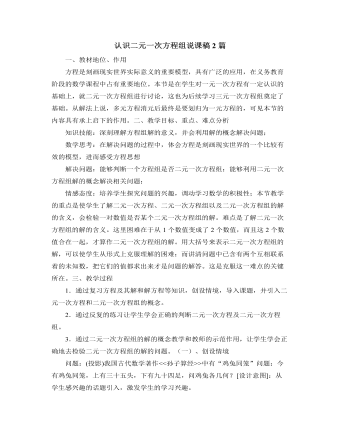
北师大版初中八年级数学上册认识二元一次方程组说课稿2篇
我们遇到的往往就是这样的方程组,我们要想比较简捷地把它解出来,就需要转化为同一个未知数系数相同或相反的情形,从而用加减消元法,达到消元的目的.请大家把解答过程写出来.解:①×3,得:6936xy??,③②×2,得:3486??yx,④③-④,得:2?y.将2?y代入①,得:3?x.根据上面几个方程组的解法,请同学们思考下面两个问题:(1)加减消元法解二元一次方程组的基本思路是什么?(2)用加减消元法解二元一次方程组的主要步骤有哪些?(由学生分组讨论、总结并请学生代表发言)[师生共析](1)用加减消元法解二元一次方程组的基本思路仍然是“消元”.(2)用加减法解二元一次方程组的一般步骤是:①变形----找出两个方程中同一个未知数系数的绝对值的最小公倍数,然分别在两个方程的两边乘以适当的数,使所找的未知数的系数相等或互为相反数.②加减消元,得到一个一元一次方程.③解一元一次方程.
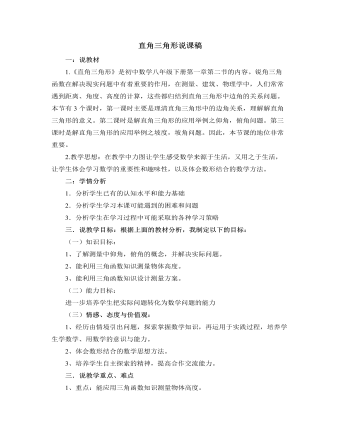
北师大版初中数学八年级下册直角三角形说课稿
2、测量。各个组的成员根据上面的设计方案在小组长的带领下到操场测量相关数据。比一比,哪组最先测量完并回到教室?(二)根据测量结果计算相关物体高度。时间为2分钟。要求:独立计算,并填写好实验报告上。(三)展示测量结果。时间为3分钟。各组都将自己计算的结果报告,看哪些同学计算准确些?(四)整理实验报告,上交作为作业。此活动主要是让学生通过动手实践,分工合作,近一步理解三角函数知识,以及从中体会学习数学的重要性,培养学生学习数学的兴趣和激情,增强团队意识。四、小结:本节课你有哪些收获?你的疑惑是什么?(2分钟)1、 知识上:2、 思想方法上:五、板书设计1、目标展示在小黑板上2、自主学习的问题展示在小黑板上3、学生设计的方案示意图在小组展示板上展示
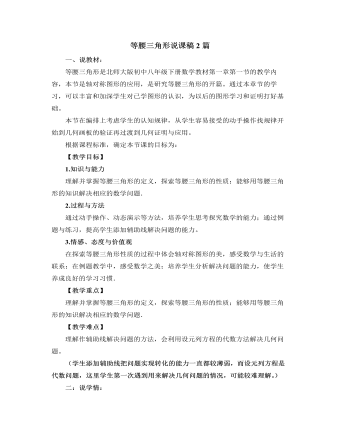
北师大版初中数学八年级下册等腰三角形说课稿2篇
一、说教材:等腰三角形是北师大版初中八年级下册数学教材第一章第一节的教学内容,本节是轴对称图形的应用,是研究等腰三角形的开篇。通过本章节的学习,可以丰富和加深学生对已学图形的认识,为以后的图形学习和证明打好基础。本节在编排上考虑学生的认知规律,从学生容易接受的动手操作找规律开始到几何画板的验证再过渡到几何证明与应用。根据课程标准,确定本节课的目标为:【教学目标】1.知识与能力 理解并掌握等腰三角形的定义,探索等腰三角形的性质;能够用等腰三角形的知识解决相应的数学问题.2.过程与方法通过动手操作、动态演示等方法,培养学生思考探究数学的能力;通过例题与练习,提高学生添加辅助线解决问题的能力。3.情感、态度与价值观 在探索等腰三角形性质的过程中体会轴对称图形的美,感受数学与生活的联系;在例题教学中,感受数学之美;培养学生分析解决问题的能力,使学生养成良好的学习习惯.

北师大版初中数学八年级下册一元一次不等式组说课稿2篇
1.通过实例体会一元一次不等式组是研究量与量之间关系的重要模型之一。2.了解一元一次不等式组及解集的概念。3.会利用数轴解较简单的一元一次不等式组。4.培养学生分析、解决实际问题的能力。5.通过实际问题的解决,体会数学知识在生活中的应用,激发学生的学习兴趣。能在解决问题过程中勤于思考、乐于探究,体验解决问题策略的多样性,体验数学的价值。四、教学重、难点分析教学重点:1.理解有关不等式组的概念.2.会解由两个一元一次不等式组成的不等式组.教学难点:在数轴上确定解集.五、教学手段分析本节课采用多媒体教学,利用多媒体教学信息容量大、操作简单、形象生动、反馈及时等优点,直观地展示教学内容,这样不但可以提高学习效率和质量,而且容易激发学生学习的兴趣,调动积极性。
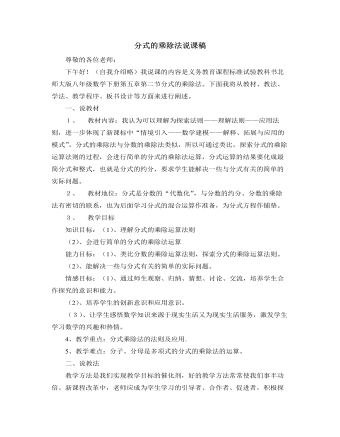
北师大版初中数学八年级下册分式的乘除法说课稿
通过以上例题帮助学生总结出分式乘除法的运算步骤(当分式的分子与分母都是单项式时和当分式的分子、分母中有多项式两种情况)4、随堂练习。(约5分钟)76页第一题,共3个小题。教学效果:在总结出分式乘除法的运算步骤后,大部分学生能很好的掌握,但是还有些学生忘记运算结果要化成最简形式,老师要及时提醒学生。 分解因式的知识没掌握好,将会影响到分式的运算,所以有的学生有必要复习和巩固一下分解因式的知识。5、数学理解(约5分钟)教材77页的数学理解,学生很容易出现像小明那样的错误。但是也很容易找出错误的原因。补充例3 计算(xy-x2)÷ ? 教学效果:巩固分式乘除法法则,掌握分式乘除法混合运算的方法。提醒学生,负号要提到分式前面去。6、课堂小结(约3分钟)先学生分组小结,在全班交流,最后老师总结。
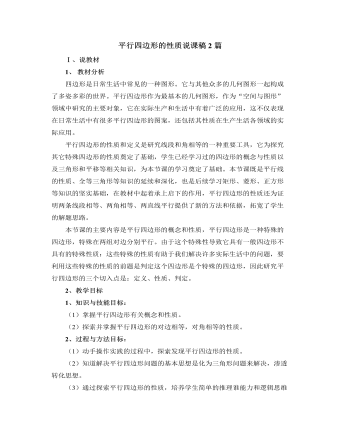
北师大版初中数学八年级下册平行四边形的性质说课稿2篇
注意:平行四边形中对边是指无公共点的边,对角是指不相邻的角,邻边是指有公共端点的边,邻角是指有一条公共边的两个角.而三角形对边是指一个角的对边,对角是指一条边的对角.(教学时要结合图形,让学生认识清楚)设计意图:通过观察图片和回顾以前的知识,使学生由感性认识上升到理性认识。通过描述平行四边形的特点和定义,也培养了学生的语言表达能力。同时也渗透了一些由实际问题转化为数学问题的“转化”的数学思想。(三)、引导实验探索新知【探究】平行四边形是一种特殊的四边形,它除具有四边形的性质和两组对边分别平行外,还有什么特殊的性质呢?我们一起来探究一下.动手操作并思考:让学生根据平行四边形的定义画一个一个平行四边形,观察这个四边形,它除具有四边形的性质和两组对边分别平行外以,它的边和角之间有什么关系?度量一下,是不是和你猜想的一致?
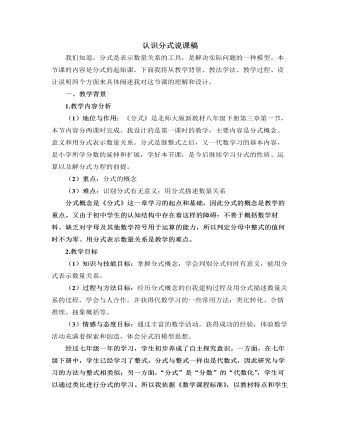
北师大版初中数学八年级下册认识分式说课稿
回顾整节课的设计,我主要着力于以下三个方面:1.关于教材处理:认真处理教材,目的只有一个——为我的学生尽可能多地提供参与活动的机会,在本节课中主要体现在以下几点:(1)通过“合成代数式”、“赋予分式实际意义”两个活动,激发兴趣,吸引学生参与活动;(2)通过“互举例子”、“填表探究”两个活动,鼓励学生主动参与活动;(3)通过“应用新知”这个环节,促进学生参与活动。2.关于教与学方法的选择:我在设计中始终关注:如何精心组织活动,让学生在丰富的活动中探索、交流与创新,因此我选择了“引导——发现教学法”,具体做法如下: (1)用数、式通性的思想,类比分数,引导学生独立思考、小组协作,完成对分式概念及意义的自主建构,突出数学合情推理能力的养成;(2)加强应用性,通过“应用新知”、“深化拓展”两个环节,密切分式与现实生活及其他学科的联系,发展数学应用意识,突出分式的模型思想。
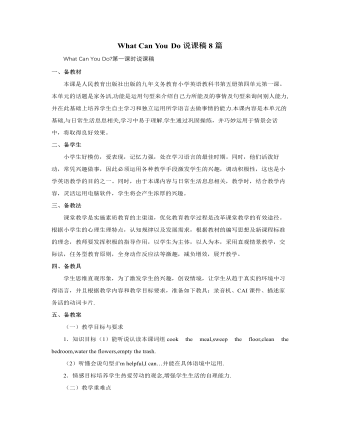
人教版新课标PEP小学英语五年级上册What Can You Do说课稿8篇
目的是让学生更深入理解Just do it的意思,能在一定情景中运用。接下来出示一些山羊妈妈的动物朋友引出课文内容。让学生先观看课文的视频,这样更生动些,也许也能更引起学生的兴趣些,因为这是一堂相对比较枯燥的读写课,有了视频观看可能更生动和有趣些。通过完成课文填空和课后回答问题,让学生既练习到写,又练习到对课文的理解,之后再让学生演一演深入课文的朗读。在最后一环节再让学生完成一个new dialogue的填空运用。这样使整堂课更完整些,学生再一次运用所学知识得到拓展。What Can You Do? PaRT B 第二课时说课稿一、教材分析1.教学内容本课主要学习有关家务劳动的表述,主要句型有:Can you ……?Yes ,I can No, I can’t .本课时的大部分动词词组在四年级上下册中都已出现过。如:Water the flowers ,sweep the floor ,set the table.2.教学目标。(1)语言技能与知识目标通过本课的学习,能够询问别人能做什么家务。如:Can you set the table ?(2)运用能力目标会用Can you…?语句询问并作出肯定或否定回答。

新人教版高中英语必修2Unit 5 Music-Listening&Speaking&Talking教案
choir memberspeople to run food stands people to sell festival ticketspeople to sell music CDspeople to set up equipmentmusical performersStep 2: Listen to the announcement again and answer the questions. ? 1. What kind of songs will Grace Davis sing at the festival?? 2. Who can try out as a performer?? 3. What can those who think they do not have musical talent do?? 4. How can students volunteer to take part?? Talking about preferences:? Would you prefer doing ..?? What would you prefer to do?? Would you rather do .... or ….?? What would you rather do?? I'd prefer .... to ..? I'd rather have ... than .. Step 3: Speaking ProjectWork in groups. Role-play the conversation or make a new one.? Debbie: Where have you been? You missed the announcement about the music festival.? John: I was at the doctor's office. Music festival?? Frank: Yes, it's going to be next month on the school sports field. John, you can play the piano. How about playing it at the festival?? John: Well, I'd rather play the violin. I can play Liang Zhu.? Frank: Wow! Sounds good. What about you, Debbie? ? Debbie: Actually, I don't have much musical ability. I'd prefer just to help out with the crowds.? Frank: You can sell tickets or work at a food stand.? John: So can I assume that the aim of the festival is to raise money?? Debbie: Yes. All of the money will go to charity.

新人教版高中英语必修2Unit 5 Music-Discovering Useful Structures教案二
4. When he got absorbed in his world of music, he felt as if he could “see” the beauty of the world around him, like he had in his previous life.P·P as adverbial: _________________________________________________________________.Function: _______________________________________________________________________.Step 5 Solid Complete the passage with the words in brackets in their correct forms.Well known as a successful band, the Impact members show quite a few striking qualities. They never ever give up. When _____________(question) by the media, they are not _____________(discourage) and practise even harder. They are improving themselves by attending several master training class. They are united. _____________(fill with) team spirit, they act as a whole, always aiming for glory. Step 6 Difference and similarity from -ingObserve the following examples.1. He went out, shutting the door behind him.=He went out, ________________________________________________________.2. Not knowing what to do, he went to his parents for help.=__________________________________________, he went to his parents for help.Similarity: _______________________________________________________________________________________________________________________________________________________.Difference : _______________________________________________________________________________________________________________________________________________________.Step Practice1. ________ in a hurry, this article was not so good. 因为写得匆忙, 这篇文章不是很好。2. ________ carefully, he found something he hadn’t known before. 他仔细读书时, 发现了一些从前不知道的东西。3. ________ why he did it, the monitor said it was his duty. 当被问及他为什么要这么做时, 班长说这是他的职责

新人教版高中英语必修2Unit 5 Music-Discovering Useful Structures教案一
Step1:自主探究。1.(教材P52)Born(bear) in the USA on 2 January 1970, Whitacre began studying music at the University of Nevada in 1988.2.(教材P52) Moved(move) by this music, he said, “It was like seeing color for the first time.”3.(教材P56)I was very afraid and I felt so alone and discouraged(discourage).4.(教材P58)Encouraged(encourage) by this first performance and the positive reaction of the audience, I have continued to play the piano and enjoy it more every day.Step2:语法要点精析。用法1:过去分词作表语1).过去分词可放在连系动词be, get, feel, remain, seem, look, become等之后作表语,表示主语所处的状态Tom was astonished to see a snake moving across the floor.汤姆很惊讶地看到一条蛇正爬过地板。Finally the baby felt tired of playing with those toys.终于婴儿厌倦了玩那些玩具。注意:1).过去分词作表语时与被动语态的区别过去分词作表语时,强调主语所处的状态;而动词的被动语态表示主语是动作的承受者,强调动作。The library is now closed.(状态)图书馆现在关闭了。The cup was broken by my little sister yesterday.(动作)昨天我妹妹把杯子打碎了。2)感觉类及物动词的现在分词与过去分词作表语的区别过去分词作表语多表示人自身的感受或事物自身的状态,常译作“感到……的”;现在分词多表示事物具有的特性,常译作“令人……的”。

新人教版高中英语必修2Unit 5 Music-Listening and Speaking教案
This lesson is about music. Students can classify the types of music through the instruments and its sound and can talk about their preferences about music, even join some activities and play a role in them according to their musical talents. On the basis, they are guided to use the languages to express their preferences and some plosive sounds and their rules.1. Classify the music types through the instruments and its sound.2. Listen and understand what the speakers’ preferences are and the reasons; talk about their own preferences and give their own reasons, using these sentences: “What kind of music do you like? And why? “ “Because it makes/gives me energy/peaceful.../touches my heart...”.3. Learn some plosives and the rules.4. Join some activities and play a role in them according to the talents. 1. Listen and understand what the speakers’ preferences are and the reasons;2. talk about their own preferences and give their own reasons, using these sentences: “What kind of music do you like? And why? “ “Because it makes/gives me energy/peaceful.../touches my heart...”.3. Learn some plosives and incomplete plosives and its rules.Step 1 Lead inPoint at the pictures on P50 and ask Q1: What are the people doing in the pictures below?Q2: What kind of music they are?Then play the MP3s one by oneStep 2 ListeningTask 1: A reporter from the school newspaper is interviewing students about music. Listen to the interviews. Draw lines between the words to make complete sentences. Some words will not be used.

新人教版高中英语必修2Unit 5 Music-Reading and Thinking教案二
1. Get basic information about Eric; read deeply to understand the history and development of the virtual choir.2. Understand what the function of the virtual choir is and how to make a virtual choir.3. Understand the meaning of some languages in the context of the text through question guidance, such as “Many people do not have close friends or contacts who have the same interest in music.” and so on.Step 1 Leading-in1. Answer the following questions.Q1:Do you know the Apps like Tik Tok and Quick Hand?Q2: Do you want to make a Tik Tok video or a Quick Hand video?2. Play a Tik Tok video Step 2: Understanding the title Q1:What does the title mean ?Q2: Is the article a narration or exposition? Why? Q3: Can you change the title ? If you can, what is the title?Step 3: Scanning the whole text and getting the basic information1. Answer the following questions.Q1:Who came up with the idea for a virtual choir?Q2: Where did Eric studied the musical composition?Q3: What is his song?2. Find the main idea of each paragraph3. Deal with some new words.Step 4: Reading carefully to get detailed informationPara 1 How to make a virtual choir1. PreparationA. tools: a virtual camera; an Internet connectionB. hero/heroin: friends or some individuals who have the same interests2. Process
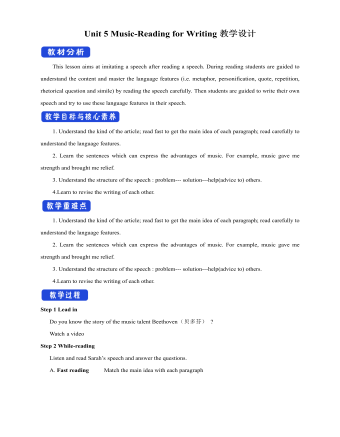
新人教版高中英语必修2Unit 5 Music-Reading for Writing教案二
The Internet celebrity Gao Yifeng. Years ago, he owned 5 companies and the staffs over 1,000, but during the economy crisis, he became nothing but debt. He was so worried that his hair became white overnight. There was a time when he wanted to killed himself. But after listening to the song Start Over by Liu Huan, he decided to cheer himself up. He started a steamed bun shop and gradually became a national chain shops. Now he became successful again.Walter Haddon said, “Music is the medicine of a troubled mind.” Music contains such a pleasant and inspiring force. Music gave him courage and bravery. When he listened to the song, it made his spirit fly like a kite in the wind. Music gave him strength and brought him relief. It was the rock I leant on to become strong and to get through those hard times. I hope none of us have to go through the same kind of suffering that he did. At the same time, we all go through various periods when we feel sad or alone. During those times, music can help us in the same way that it helped him. I hope we all will somehow begin to treasure music and make it a part of our life. Thank you for your listening !5.Revise your writing each other.Does he/she explain how music has changed his/her/someone else’s life?Are some of the rhetorical devices included and used properly ?Does he/she talk about how music makes him/her/someone feel?Is the first word in each sentences capitalised?Does he/she use correct punctuation ?

新人教版高中英语必修2Unit 5 Music-Reading For Writing教案一
(4)Now we have heard a number of outstanding speeches ... 我们已经聆听了许多精彩的发言……(5)Because we wanted the nations of the world, working together, to deal with ... 因为我们希望全世界各国团结起来去应对……(6)And if we do not act ... 如果我们不采取行动……(7)Now, I share the concerns that have been expressed ... 我也同意对于……表达的担心(8)Let us show the world that by working together we can ... 让我们告诉全世界,通过一起努力我们可以……(9)It is now time for us to ... 是时候我们……(10)And I have always wished that ... 我一直希望……(11)Thank you for letting me share this day with me.感谢你们和我共度这一天。实践演练:假如你是高中生李华,你校将举办一次以“音乐”为主题的演讲比赛,请你按照主题,写下你的演讲稿。注意:词数100左右。First of all, thank you for listening to my speech. My topic is: love music like love yourself.Music is like the air we need to maintain our normal lives around us. You can't imagine how terrible a world without music would be. Movies and TV shows have no music, only dry conversations and scenes; mobile phones only vibrations; streets only noisy crowds; cafes, western restaurants only depressed meals. What a terrible world it is!As a student, I hope we all can enjoy the fun brought by music in our spare time. Instead of just listening to music, we can even make our own music. Let's enjoy the fun of music!Thanks again for your attention!
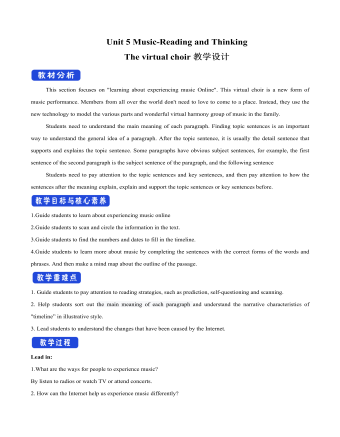
新人教版高中英语必修2Unit 5 Music-Reading and Thinking教案一
This section focuses on "learning about experiencing music Online". This virtual choir is a new form of music performance. Members from all over the world don't need to love to come to a place. Instead, they use the new technology to model the various parts and wonderful virtual harmony group of music in the family. Students need to understand the main meaning of each paragraph. Finding topic sentences is an important way to understand the general idea of a paragraph. After the topic sentence, it is usually the detail sentence that supports and explains the topic sentence. Some paragraphs have obvious subject sentences, for example, the first sentence of the second paragraph is the subject sentence of the paragraph, and the following sentenceStudents need to pay attention to the topic sentences and key sentences, and then pay attention to how the sentences after the meaning explain, explain and support the topic sentences or key sentences before.1.Guide students to learn about experiencing music online2.Guide students to scan and circle the information in the text.3.Guide students to find the numbers and dates to fill in the timeline.4.Guide students to learn more about music by completing the sentences with the correct forms of the words and phrases. And then make a mind map about the outline of the passage.1. Guide students to pay attention to reading strategies, such as prediction, self-questioning and scanning.2. Help students sort out the main meaning of each paragraph and understand the narrative characteristics of "timeline” in illustrative style.3. Lead students to understand the changes that have been caused by the Internet.
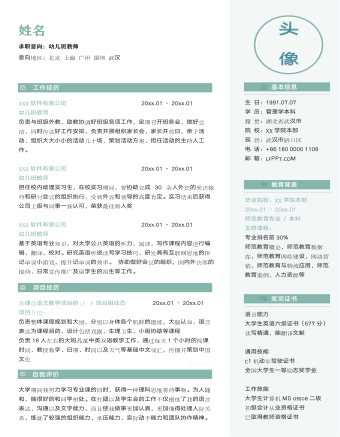
英语外教幼儿班实习教师简历
新课改语文教学项目研讨 / 项目组成员 20xx.01 – 20xx.01项目介绍:负责整体课程规划和大纲,分别以身体各个肌群的锻炼,大脑认知,语言表达为课程目的,设计包括戏剧、生理卫生、小组协助等课程负责18人左右的大班儿童中英双语教学工作,通过每天1个小时的授课时间,教授数字、日期、时间以及天气等基础中文词汇,传播并策划中国文化
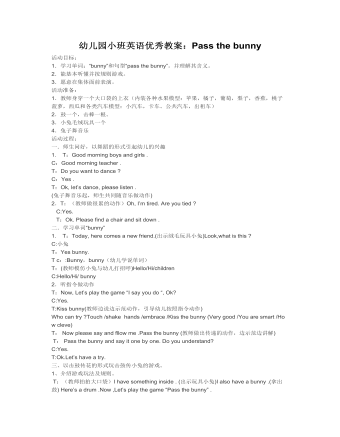
幼儿园小班英语优秀教案:Pass the bunny
2.能基本听懂并按规则游戏。 3.愿意在集体面前表演。 活动准备: 1.教师身穿一个大口袋的上衣(内装各种水果模型:苹果,橘子,葡萄,梨子,香蕉,桃子菠萝,西瓜和各类汽车模型:小汽车,卡车。公共汽车,出租车) 2.鼓一个,击棒一根。 3.小兔毛绒玩具一个 4.兔子舞音乐 活动过程: 一.师生问好,以舞蹈的形式引起幼儿的兴趣 1. T:Good morning boys and girls . C:Good morning teacher .T:Do you want to dance ?C:Yes . T:Ok, let’s dance, please listen .(兔子舞音乐起,师生共同随音乐做动作) 2.T:(教师做很累的动作)Oh, I’m tired. Are you tied ? C:Yes. T:Ok. Please find a chair and sit down .

人教版新课标PEP小学英语三年级下册Do you like pears说课稿9篇
第一环节:教师参与到其中的一个小组,用“Do you like…?”的句型提问,因为学生在上学期已经接触了“like”一词,现在又有了前面三次听的机会,对本课所要学的对话有了一定的感知,预计有部分学生会回答“Yes,Ido.或No,I don’t .”当学生回答“Yes,Ido.”时,我就说:“Here you are .”同时也将水果递给学生。在教师与学生、学生与学生的对话中,领悟了“Yes,Ido.”和“Here you are .”的意思。当学生回答“No, I don’t.” 时,教师不把水果递给他。通过这个过程的口语与演示,学生也会领悟到“No, I don’t.”的意思。同时,进行师问生答的口语操练。师生对话要适当增加,使学生对“Yes,Ido.和No, I don’t”的句型有更多的操练机会。这样,第一环节的目标也就达到了。第二环节:由师问生答的形式,变为生问师答。通过教师引导,让学生用“Do you like …”提问。因为,学生要把“Do you like …”的音读准,有一定难度。因此,在起先学生说这句式时,要发挥教师的主导作用,让学生跟读,注重学生发音的准确。

人教版新目标初中英语七年级下册Why do you like koalas说课稿4篇
通过Go for it七上的学习,大部分学生对why/what/where引导的特殊疑问句已具备较强的听说能力,而本单元围绕“animals”的教学活动贴近学生生活,学生有强烈的兴趣和好奇心,使他们产生了解的欲望,有利于引导他们自主学习。本单元的教学内容我是用了三节课完成,又用了第四节来复习。七班的学生大部分性格偏内向,不喜欢表达和展现自己,但大部分同学有一定的英语基础,通过教师的恰当引导,能完成教学任务。教材分析:本单元的topic是animals, 要求学生掌握一些新的动物名词,学会用表示性质和品质的形容词来描述动物,并能用“Why do you like…? Because….” 来陈述喜欢的原因。通过讨论动物,让学生了解大自然,增长地域知识,增进对自然环境的情感;通过讨论自身的喜好及原因,提高学生的认知和思维能力。教材在第一、第二单元的基础上对已有的语言项目进行拓展,符合学生的认知规律,循序渐进。